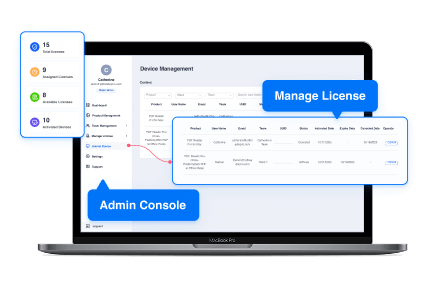
How to Write an Affidavit

Writing an affidavit can seem daunting, but with the right guidance and understanding, it's a straightforward process.
An affidavit is a legal document used in various situations, from financial affidavits in legal proceedings to affidavits of death in the probate process.
This guide will walk you through the steps of creating an effective affidavit.
What is an Affidavit?
An affidavit is a written statement confirmed by oath or affirmation, used as evidence in court.
It's a formal statement where the affiant (the person making the affidavit) declares the information is accurate to the best of their personal knowledge or first-hand knowledge.
The key here is that the information must be something the affiant has directly experienced or witnessed, not hearsay or speculation.
The Different Types of Affidavits
There are various affidavit types, each serving a specific purpose. Some common types include:
- Affidavit of Residence: Verifies where a person lives. See PDF Reader Pro's Affidavit of Residence for more details.
- Financial Affidavits: Used in legal disputes involving finances.
- Affidavit of Death: Required in the probate process to establish a deceased person's death.
- Affidavit of Heirship: Identifies the heirs of a deceased person.
- Non-Specific Affidavit: A general affidavit for situations that don't fit into a specific category.
Each affidavit type requires different information, so ensure you're using the right one for your needs.
Get the steps on how to write a compelling petition with our guide, empowering you to mobilize support and effect change.
How to Draft an Affidavit
In the legal landscape, drafting an affidavit is a critical skill. An affidavit is a sworn statement of fact, pivotal in various legal contexts, from court proceedings to formal transactions.
Understanding how to draft an affidavit effectively ensures that your statements are not only clear and concise but also legally sound and binding:
-
Choose the Right Affidavit Form: Various affidavit forms are available, tailored to different situations. Select the one that best fits your needs.
-
Include Personal Details: Start by providing your name, address, and other relevant personal details.
-
Statement of Truth: Affirm that the information provided is true to your knowledge. This statement is crucial, as making a false statement under oath can lead to penalties, including jail time.
-
Detail the Facts: Clearly and concisely state the facts. This should be factual evidence, not opinions or beliefs.
-
First-Hand Knowledge: Ensure all information is based on your direct experience or knowledge.
-
Attach Relevant Documents: If applicable, attach documents like bank statements, financial statements, marriage certificates, or witness statements to support your affidavit.
-
Notary Signature Block: The affidavit must be signed in the presence of a qualified person, such as a notary public. Their signature and seal validate the affidavit.

Utilizing an Affidavit PDF Template
For those seeking to draft an affidavit, PDF Reader Pro offers a valuable tool: the "General Affidavit PDF Template."
This template is especially useful for individuals who need to create a non-specific affidavit, which can be adapted to various situations where a specialized form is not required.
Key Features of the Template:
- Ease of Use: The template is designed for simplicity and ease of use. It guides you through the necessary fields, ensuring that all crucial details are included.
- Customizable: While it comes pre-formatted with the essential elements of an affidavit, the template allows for customization to suit your specific needs.
- Legally Compliant: The template is structured to comply with legal standards, ensuring that your affidavit meets the necessary requirements.
- Accessibility: With PDF Reader Pro, you can access, fill, and edit this template on various devices, enhancing convenience and efficiency.
Get the steps on how to write a notarized statement effectively with our guide, ensuring legal acknowledgment and validity.
Legal Considerations for Affidavits
Remember that an affidavit is a legal document, and signing it under the penalty of perjury means you're legally responsible for its contents.
It’s used in various legal proceedings, insurance claims, and more, so accuracy and truthfulness are paramount.
See the most important legal considerations below:
-
Penalty of Perjury: Signing an affidavit means you are declaring under oath that the contents are true to the best of your knowledge. False statements can lead to legal consequences, including perjury charges.
-
Accuracy and Truthfulness: Ensure every detail in the affidavit is accurate. This includes names, dates, and relevant details. Even small inaccuracies can undermine the document's credibility.
-
Numbered Paragraphs: Organize the affidavit in numbered paragraphs. This makes the document clear and easy to reference in legal proceedings.
-
Relevant Details: Include all details pertinent to the matter at hand. Irrelevant information can distract from the key points and weaken the affidavit's effectiveness.
-
Legal Identification: Provide proper identification for all parties involved. This might include full legal names, addresses, and other identifying information.
-
Step-by-Step Process: Follow a structured process when filling out the affidavit. This includes providing your personal details, stating the facts, and signing in front of a notary.
-
Use in Various Legal Proceedings: Understand that affidavits are used in a wide range of legal contexts—from civil proceedings in county courthouses to insurance claims and the transfer of assets.
-
Sending the Affidavit: If you need to submit the affidavit to a law office, court, or other legal entity, ensure you have the correct mailing address. For sensitive documents, consider using registered mail or courier.
Writing an affidavit requires careful attention to detail and an understanding of the legal implications. By following these steps and ensuring all information is based on personal knowledge and truth, you can effectively draft an affidavit for any legal need. PDF Reader Pro can assist in managing and filling out your affidavit forms, making the process smoother and more efficient.
Remember, when in doubt, consulting legal experts can provide additional guidance specific to your situation.

How to Draft an Affidavit: Best Practices
Drafting an affidavit, a crucial legal document, requires precision and adherence to specific guidelines. Here are some best practices to follow, ensuring your affidavit is effective and compliant with legal standards.
1. Choose the Correct Type of Document
An affidavit can serve various purposes, from financial declarations to statements in business transactions. Ensure you're using the correct type of affidavit for your specific needs. For instance, a financial affidavit differs significantly from one used in business transactions.
2. Use a Numbered List for Clarity
Organize the facts in a clear, concise manner using a numbered list. This format aids in readability and ensures that each point is distinctly understood and referenced.
3. Provide Complete and Accurate Information
Your affidavit should offer a complete representation of the relevant facts. For example, if the affidavit involves financial affairs, include detailed information about the financial institutions and accounts in question.
4. Reference Real People Correctly
If your affidavit involves other individuals, such as in a business transaction, ensure to refer to them by their full legal names. For example, use "Jane Doe" or "John Doe" rather than nicknames or incomplete names.
5. Ensure the Affidavit Reflects Current Information
The information in your affidavit should be up-to-date and reflect the current state of affairs. This is particularly important in financial affidavits where the status of accounts and transactions can frequently change.
6. Review for Accuracy and Completeness
Before finalizing, review the affidavit thoroughly to ensure all information is accurate and no essential details are omitted. An affidavit with errors or incomplete information can lead to legal complications.
By following these best practices, you can create an affidavit that is not only legally sound but also clear and effective for its intended purpose. Remember, the key to a successful affidavit lies in its precision, organization, and truthfulness.
How to Draft an Affidavit: FAQ
Can I Create an Affidavit in Minutes?
Yes, you can create an affidavit in minutes, especially if you use a template or a guided format. Simple affidavits, like an Affidavit of Service or a Standard Affidavit, often require just basic personal information and the relevant facts.
What Is the Formal Affidavit Format?
A formal affidavit format typically includes a title, the affiant's (person making the affidavit) personal information, numbered paragraphs detailing the facts, a statement of truth, affiant's signature, and a notarial certificate. Clarity and conciseness are key in this format.
How Do I Correct a Mistake in an Affidavit?
If you make a mistake in an affidavit, such as a spelling error, you should create a second affidavit (or an addendum to the original) that clarifies and corrects the mistake. It's important to address any inaccuracies promptly to maintain the document's integrity.
Is There a Specific Type of Affidavit for Identity Theft?
Yes, there are situation-specific affidavits like the Identity Theft Affidavit. These are used to formally assert an identity theft claim, often required by financial institutions or law enforcement agencies.
What's the Difference Between Legal and Standard Affidavits?
A legal affidavit is typically used in formal legal proceedings and may require specific language or formatting as per legal guidelines. Standard affidavits are more general-purpose documents used in less formal situations.
Can I Draft an Affidavit Tailored to My Specific Situation?
Yes, you can draft situation-specific affidavits tailored to your unique circumstances. These affidavits are customized to address specific issues or events, like business transactions or financial affairs.
How Do I Draft an Affidavit Document?
To draft an affidavit document, start with the correct type of affidavit for your needs. Include your personal details, state the facts in a clear, numbered list, sign the document, and have it notarized. Ensure the information is truthful and represents a complete representation of the facts.
What Are the Consequences of Filing a False Affidavit?
Filing an affidavit false under oath can lead to serious legal consequences, including charges of perjury.
Learn the essentials of writing an addendum to a document with our detailed instructions, ensuring your additions are clear and legally sound.











 Free Download
Free Download  Free Download
Free Download
